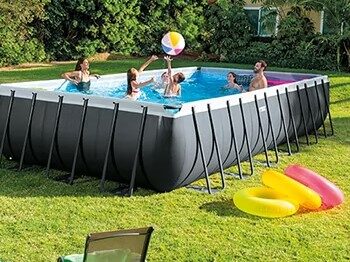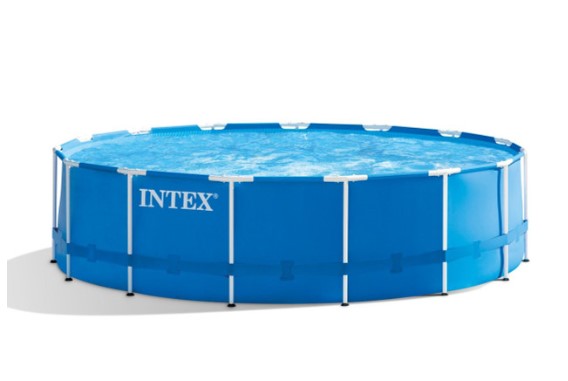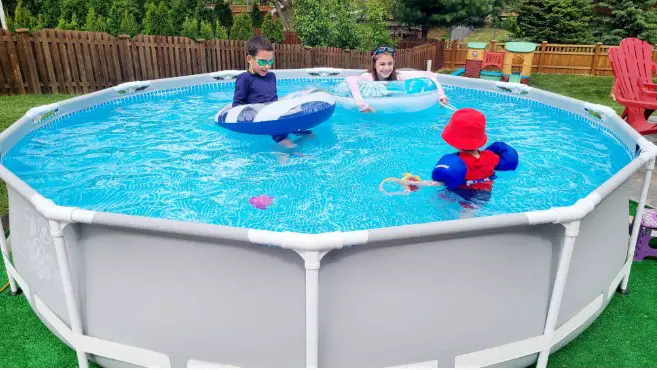Table of Contents
Having an Intex pool in your backyard is an excellent way to stay cool during the hot summer months. One of the essential components ensuring your pool remains a clean and safe place to swim is your Intex pool filter.
This essential piece of equipment keeps your pool water crystal-clear and free from dirt and debris. So how do you know if your Intex pool filter is working as it should?
First, start by understanding the typical signs of a properly functioning filter. A clean, clear pool with minimal debris at the bottom is usually a good indication that your filter is doing its job.
However, you may encounter problems that prevent your pool filter from working at optimal capacity, such as cloudy water, excessive dirt buildup, or a noisy pump.
In this article, we will discuss ways to assess if your Intex pool filter is working correctly and what steps to take if you encounter any issues.
Knowing when your Intex pool filter is operating effectively is crucial, as it maintains the water quality and prolongs the life of your pool.
In addition to visual checks, you should also ensure routine maintenance, such as cleaning and replacing the filter cartridge, is performed as needed. By doing so, you can confidently enjoy your Intex pool, knowing that the water is clean and safe for you and your family.
Understanding Intex Pool Filters
Intex pool filters are essential for maintaining a clean and healthy swimming environment. These filters remove debris and contaminants from the pool water, ensuring the water remains clear and safe for swimming.
In this section, we will discuss the different types of Intex pool filters and how to identify if your filter is functioning properly.
Types of Intex Pool Filters
There are two main types of Intex pool filters: sand filters and cartridge filters.
Sand Filters
- Sand filters use specially graded sand to trap debris and contaminants.
- They require backwashing to clean the filter as the sand collects dirt over time.
- Sand filters are known for their durability and low maintenance requirements.
Cartridge Filters
- Cartridge filters use a replaceable fabric cartridge to catch debris and contaminants.
- They need to be cleaned periodically by removing and rinsing the cartridge.
- Cartridge filters are highly efficient and effective at trapping smaller particles.
To determine if your Intex pool filter is working, observe the following factors:
- Water clarity: Check the pool water for clarity. If the water appears cloudy or murky, it could indicate that the filter is not effectively removing debris and contaminants.
- Filter pressure: Most Intex pool filters have a pressure gauge, which indicates the amount of resistance in the system. A higher reading can mean that the filter is clogged and needs cleaning or replacement.
- Debris in the pool: If you notice an increased amount of debris in the pool, such as leaves and grass, it might be a sign that your filter is not efficiently capturing these particles.
- Cartridge condition: In the case of cartridge filters, visually inspect the cartridge for any damage or excessive buildup of debris. If it’s dirty or damaged, clean or replace the cartridge.
By understanding the Intex pool filter system and regularly monitoring its performance, you can ensure a well-maintained and enjoyable swimming experience.
Signs Your Intex Pool Filter Is Working Properly
Water Flow
One of the primary indicators of a properly functioning Intex pool filter is consistent water flow. When your filter is working effectively, you’ll observe that the water circulation in your pool remains steady. This is important, as proper water flow prevents the buildup of algae and other impurities that can affect the pool water’s cleanliness.
Clarity
Another sign that your Intex pool filter is performing well is the clarity of the pool water. A functioning pool filter should effectively remove impurities such as dirt, debris, and algae from the water, resulting in clear and sparkling pool water.
To maintain the cleanliness of your pool water, be sure to perform regular pool care, including:
- Monitoring the water chemistry and adjusting as necessary
- Checking and cleaning your pool filter
- Skimming debris from the pool surface
- Brushing and vacuuming the pool walls and floor
By paying close attention to the water flow and clarity, as well as engaging in regular pool care, you can ensure that your Intex pool filter remains in optimal working condition, keeping your pool water clean and enjoyable.
Potential Issues with Intex Pool Filters
Clogs and Leaks
One common issue with Intex pool filters is clogging. Clogs can occur when debris, such as leaves and dirt, get caught in the filter system.
To prevent clogs, make sure to clean your pool regularly and remove any visible debris before it gets trapped in the filter. Additionally, ensure the filter cartridge is clean and free of contaminants.
Leaks can also develop in the pool filter, particularly at the valve or o-ring. Inspect these areas and check for any visible signs of damage or wear.
If you find an issue, replace the faulty parts as needed. Regularly check for air leaks as well, as these can lead to inefficient filtering.
Pressure Issues
Another potential problem with Intex pool filters is incorrect filter pressure. Monitor your pressure gauge and refer to your owner’s manual for the recommended pressure range for your specific filter system.
If the pressure is too high or too low, it may indicate an issue with the filter system, like a clog or a leaking valve.
Keep an eye out for any sudden changes in pressure, as this may signal a problem that needs troubleshooting.
Broken Parts
Intex pool filters can experience broken or damaged parts, such as the impeller or pressure gauge. Inspect your filter system regularly for any visible signs of damage or wear, and replace any broken parts as needed.
Remember to turn off the pool filter system before performing any maintenance to avoid accidental injury or damage to the equipment.
By regularly checking for clogs, leaks, pressure issues, and broken parts, you can ensure your Intex pool filter remains in good working condition and effectively filters your pool water.
Troubleshooting Tips for Intex Pool Filters
Check for Clogs and Debris
Clogs and debris can significantly hinder your pool filter’s performance. Regularly check your filter media for any signs of buildup. Clean or replace the filter media as recommended by the manufacturer.
Additionally, ensure your pool’s vacuum and hoses are free from debris and functioning correctly. This will promote better circulation and filtration of your pool water, resulting in a cleaner and safer swimming environment.
Examine Pressure and Valves
It’s essential to frequently examine your Intex pool’s pressure and valves. A high filter pressure gauge reading can indicate a filter issue, such as clogs or improper backwashing. Be sure to:
- Monitor the filter gauge for any sudden changes or unusual readings
- Check the backwash valve for signs of leaking or malfunction
Proper pool maintenance includes regularly backwashing your pool according to the manufacturer’s guidelines. Doing so helps maintain optimal filtration and reduces the likelihood of harmful bacteria growth.
Inspect and Replace Broken Parts
Over time, the components of your Intex pool’s pump and filter system may wear down or become damaged. Regular inspection can help identify and address these issues in a timely manner. Here’s what to look for:
- Check the pool pump for any leaks or strange noises
- Inspect the filter tank for any cracks or signs of wear
- Examine the hoses, valves, and other components for damage or deterioration
When you identify broken or worn-out parts, replace them with genuine Intex replacement parts to ensure optimal performance and prolong the life of your filter system. Regular pool maintenance and troubleshooting will help keep your Intex filter working efficiently, providing you with a clean and healthy swimming environment.
Maintenance and Care for Intex Pool Filters
Cleaning and Replacing Filter Media
To ensure your Intex pool filter is working properly, it’s essential to perform regular cleaning and maintenance of your filter media. If you have an Intex Krystal Clear cartridge filter pump, follow these steps to clean the cartridges:
- Turn off the filter pump and disconnect it from the power supply.
- Open the air release valve to release any built-up pressure.
- Open the filter housing and remove the cartridge.
- Rinse the cartridge thoroughly using a garden hose, making sure to remove any debris from the pleats.
- If the cartridge is heavily soiled or damaged, it’s time to replace it.
It’s essential to keep an eye on the skimmer basket and clean it regularly to prevent debris from entering the filter system:
- Empty the skimmer basket by removing and cleaning it every 2-3 days or when visibly dirty.
- Regularly check the pool’s chemical balance to maintain optimal pH levels for your Intex filter’s efficiency.
Backwashing and Rinsing Filters
For those using Intex sand filters, backwashing and rinsing the filter are crucial steps in pool care. Here’s a brief guide on how to backwash and rinse your sand filter:
- Switch off the filter pump and affix the backwash hose to the filter’s backwash port.
- Turn the 6-way valve to the “Backwash” position and restart the filter pump. The water should flow through the standpipe and out of the hose. Continue backwashing for 3-5 minutes or until the water coming out of the hose is clear.
- Switch off the pump and switch the valve to the “Rinse” position. Turn on the pump and rinse for about 20-30 seconds to remove any remaining debris.
- Turn off the pump, set the valve back to the “Filter” position, and restart the pump for normal operation.
By performing these maintenance tasks, your Intex pool filter should provide efficient filtration, ensuring a clean and debris-free pool. Remember to always consult your filter’s owner’s manual for specific instructions and recommendations.
Comparing Intex Pool Filters to Other Brands
Intex pool filters are popular choices for maintaining clean water in above-ground pools. Comparatively, Bestway is another well-known brand in the market that offers similar products. To understand the differences between Intex and Bestway pool filters, we need to examine some essential aspects.
Both Intex and Bestway offer filter cartridges designed specifically for their swimming pool models. These cartridges are made of durable materials, ensuring optimal performance and a long-lasting lifespan.
However, while Intex filters are often lauded for their easy installation and maintenance, Bestway filters may offer slightly more advanced features, like built-in chemical dispensers.
In terms of pool construction, Intex is known for its sturdy and high-quality vinyl liners in their above-ground pools.
Meanwhile, Bestway also provides reinforced vinyl liners, but some models may come in different shapes and sizes compared to Intex.
When choosing a pool filter for your above-ground pool, it’s essential to consider compatibility.
Ensure that the filter you select is designed for your specific pool model, as both Intex and Bestway filters are generally only compatible with their respective pools.
Pricing may play a role in your decision-making process as well. While both brands typically offer affordable options, keep in mind that the cost of replacement filter cartridges may vary.
It’s essential to weigh your budget and maintenance requirements before deciding which brand suits your needs best.
To summarize, both Intex and Bestway pool filters offer reliable performance and durability for above-ground pools.
Factors such as compatibility, pool design, and pricing may help determine which brand is ultimately the best fit for your specific needs.



